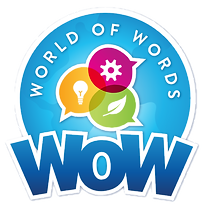


_JPG.jpg)

Welcome to a World of Words!
About WOW
World of Words (WOW) is a research-based shared reading program to help young children develop vocabulary, concept knowledge and content knowledge in science.
The WOW supplemental curriculum is designed to accelerate children’s oral language and vocabulary through fascinating topics that relate to the life, biological and physical sciences.The curriculum integrates multiple sources of information and technology to accelerate children’s literacy development in content areas aligned with national pre-kindergarten standards. In collaboration with the creators of Sesame Street®, WOW uses child-friendly media to support children’s learning as they encounter new words and concepts in science, mathematics, social studies, and health. Throughout the WOW curriculum, teachers guide children through developmentally appropriate exercises to increase literacy skills while developing their knowledge and vocabulary in academic content areas.

WOW is recognized by the Institute of Education Sciences as having Tier 1 evidence for Language development: the highest level for evidence of effectiveness.
Watch WOW lessons in action!
Why WOW?
Vocabulary knowledge and oral language comprehension is central to children’s early and long-term literacy success (Cunningham & Stanovich, 1997). Moreover, studies have shown that the size of a child’s vocabulary in kindergarten is an effective predictor of reading comprehension in the middle elementary years (Scarborough, 2001), and vocabulary size at the end of Grade 1 is a significant predictor of reading fluency and comprehension in high school (Stahl & Nagy, 2006).

Multiple studies have confirmed that children gain and sustain word and conceptual knowledge from WOW curriculum. The Institute of Education Science What Works Clearinghouse recognizes WOW as showing Tier 1 evidence: strong evidence of improved student language. Read the report here.
How does WOW work?
A year of the WOW curriculum includes six different text sets: six books from multiple genres. Each text set begins with one or more predictable books, followed by one or two narrative nonfiction books, and finally by an expository text. Picture cards are included for each topic to emphasize the important properties of the category, and to provide additional visual aids.
Each text set has six teacher lesson plans, highlighting the target words to be taught, the concepts to be developed, and before, during and after reading activities.

Lessons consist of three segments:
Talk Together: to introduce new vocabulary and concepts, and build background knowledge
Read Together: to develop content and conceptual knowledge
Reflect Together: to support higher order thinking skills and connect concepts across topics
WOW is optimally utilized during the Morning Meeting, when children gather together to begin their daily activities. Teachers introduce words explicitly, read- and re-read the text, stopping only at key points to clarify the meaning of words or concepts. Following the reading, teachers ask challenge questions that focus on new words within and outside the category, helping children to build knowledge of the properties of certain concepts, and encouraging them to develop higher order thinking skills.
Each text set is to be used over a two-week period, for a 20-week intervention.
The Evidence
Neuman, S. B., & Kaefer, T. (2025). Knowledge-Building Through Categorization: Boosting Children’s Vocabulary and Content Knowledge in a Shared Book Reading Program. Early Education and Development, 1-20. [available here]
Neuman, S. B., & Danielson, K. (2021). Enacting content-rich curriculum in early childhood: The role of teacher knowledge and pedagogy. Early Education and Development, 32(3), 443-458. [available here]
Neuman, S. B., Samudra, P., & Danielson, K. (2021). Effectiveness of scaling up a vocabulary intervention for low-income children, pre-K through first grade. The Elementary School Journal, 121(3), 385-409. [available here]
Neuman, S.B. & Danielson, K. (2020). Enacting Content-rich Curriculum in Early Childhood: The Role of Teacher Knowledge and Pedagogy. Early Education and Development. [available here]
Neuman, S. B. (2019). First Steps toward Literacy: What Effective Pre-K Instruction Looks Like. American Educator, 42(4), 9. [available here]
Neuman, S. B., & Kaefer, T. (2018). Developing low-income children’s vocabulary and content knowledge through a shared book reading program. Contemporary Educational Psychology, 52, 15-24. [available here]
Neuman, S. B., Kaefer, T., & Pinkham, A. M. (2016). Improving low-income preschoolers’ word and world knowledge: The effects of content-rich instruction. The Elementary School Journal, 116(4), 652-674. [available here]
Neuman, S. B., Pinkham, A., & Kaefer, T. (2015). Supporting vocabulary teaching and learning in prekindergarten: The role of educative curriculum materials. Early Education and Development, 26(7), 988-1011. [available here]
Neuman, S. B., & Kaefer, T. (2013). Enhancing the intensity of vocabulary instruction for preschoolers at risk: The effects of group size on word knowledge and conceptual development. The Elementary School Journal, 113(4), 589-608. [available here]
Neuman, S. B., & Dwyer, J. (2011). Developing vocabulary and conceptual knowledge for low-income preschoolers: A design experiment. Journal of Literacy Research, 43(2), 103-129. [available here]
Neuman, S. B., Newman, E. H., & Dwyer, J. (2011). Educational effects of a vocabulary intervention on preschoolers’ word knowledge and conceptual development: A cluster‐randomized trial. Reading Research Quarterly, 46(3), 249-272. [available here]
Neuman, S. B., & Dwyer, J. (2009). Missing in action: Vocabulary instruction in pre‐K. The reading teacher, 62(5), 384-392. [available here]







